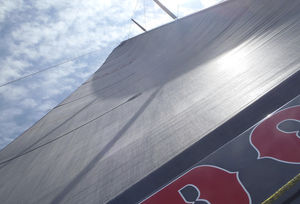
- Sailing
- Sailing Equipment and Gear
- Mainsail
- UK-Halsey International
Mainsail X-Drivefor regatta sailboatscarbonfull-batten
Add to favorites
Compare this product
fo_shop_gate_exact_title
Characteristics
- Type
- mainsail
- Applications
- for regatta sailboats
- Material
- carbon
- Other characteristics
- full-batten
Description
Depending on the boat size, performance level, weight and price, carbon X-Drive load-path fibers can be bonded to laminates reinforced with aramid scrims as shown above, or laminates reinforced with polyester scrims. Both laminates can gain chafe protection with a taffeta layer; the extra longevity comes at the price of extra weight and cost.
Carbon fiber is the highest performance yarn used in sailmaking. As seen below, carbon yarns are at the top of the chart in three out of four ways to measure their performance. Carbon fiber’s resistance to stretch is three times greater that S-Glass yarns, which are three times more stretch resistant than polyester yarns.
X-Drive Carbon main video. The continuous carbon fibers are on a black polyester laminate.
X-Drive Carbon main video. The continuous carbon fibers are on a black polyester laminate.
The almost complete coverage of continuous load path yarns on the sail leads to a smooth flying shape. UK Sailmakers’ yarn laying machine puts down up to 11 yarns at a time, which means there are hundreds of continuous yarns on the sail. Since each yarn has 4,000 carbon filaments there are up to 44,000 filaments of carbon are laid at time, giving the sail great strength along with the ability to keep its designed shape without distortion. This means UK Sailmakers can use lighter and less expensive laminates and those savings are passed on to sailors.
All the carbon yarns used in X-Drive yarns are dry (not coated in glue) which keeps them from becoming brittle. Keeping the carbon yarns dry improves their flexibility.
Catalogs
X-Drive
4 Pages
RACING MAINSAIL
4 Pages
*Prices are pre-tax. They exclude delivery charges and customs duties and do not include additional charges for installation or activation options. Prices are indicative only and may vary by country, with changes to the cost of raw materials and exchange rates.





